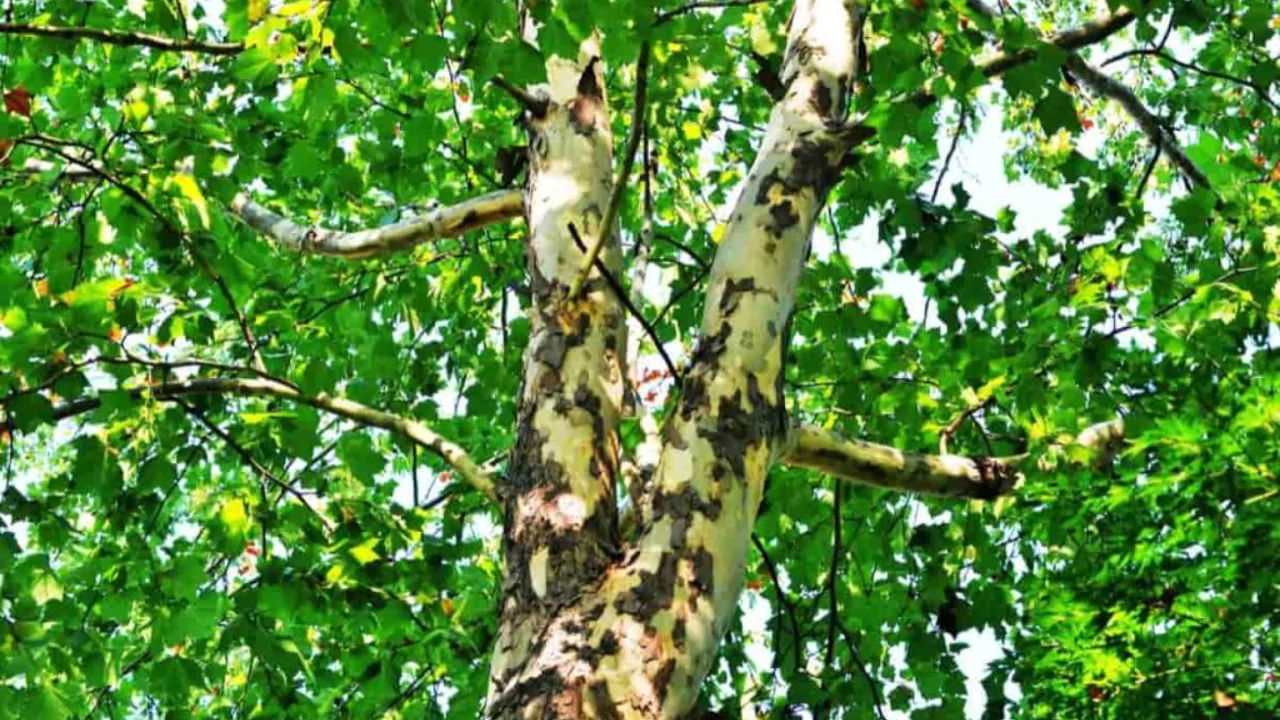
Similar to maples and oak trees, sycamores (Platanus occidentalis) are common to the eastern part of the United States. These distinguished trees have several names, like American planetree and Button-wood or Button-ball tree, and are recognized easily by their leaves, seeds, and bark.
Sycamore trees have large, light green leaves that are similarly shaped to maple leaves. The leaves are also alternate and simple. Sycamore trees leaves are known to turn yellow or brown in autumn. The undersides of newer leaves have white coarse hair.
Younger branches of a sycamore are covered with mottled white or grey bark. In addition, a sycamore’s bark is unique as darker grey or red older bark can be found. Sycamore’s unique seed balls are 1 inch in diameter and tan to brown in color. They are individually formed on slender stems during sunmer.
These trees can reach remarkable heights of 100 or more feet, and can grow rapidly in their younger years. Older trunks on the other hand, may measure 7 feet in diameter along with the tree’s distinct seed balls.
Their shape junior trees grow in a rounded and expanding manner. These trees prosper along stream, woodland regions where soil is moist. Their climatic preference is nasty planting from zone 4 to 9.
Growing Sycamore Trees
Sycamores, alongside willows and cottonwoods, can be considered as fast growing trees, however unlike them, sycamores are able to withstand snow and high velocity winds which adds to their strength. Moreover, sycamores are considered to be long-lasting trees as long as they are not infected by any sort of disease.
As a result of being able to provide ample shade, they are extremely easy to propagate from hardwood cuttings, given the fact that the area has enough space.
Sycamores are massive trees that do not work with home landscaping and are difficult to maintain. First, the sheer size Sycamores posses serves as an issue, but on top of that their widespread aggressive root systems also damage plumbing, patios, sidewalks. Sycamores are also known to be messy trees because of the large amount of leaves, twigs and seeds they drop.
Public parks and grounds usually plant Sycamores because they are able to provide and endure urban conditions such as packed soil or salt and even alkaline soil.
To maintain a sycamore tree, insert a hardwood cutting or sapling during the spring in soil that is moist and deep.
Sycamore trees like moist soil but will adapt to drier soil as they grow older. During the first growing season, the soil has to be kept evenly moist throughout the season for the roots to properly establish themselves.
To promote a single strong central branch, prune sycamores in late winters and remove any rubbing branches. If any other leader branches develop, cut them out too.
Diseases and Pests
Anthracnose
The most serious and common disease affecting sycamore trees is anthracnose. This disease will be the worst for the trees after having a cool and wet spring.
It manifests as dark, sunken cankers on the head and the branches. A recurring cycle of terminal bud growth and death gives the branches a ‘witch’s broom’ appearance.
You will notice black fungal growths on the branches as well. Leaves will turn brown, get mottled and drop off the tree prematurely. In order to control anthracnose, all leaves in the fall need to be removed and destroyed. Do not compost them.
In the winter when the tree is dormant, prune out the cankered branches. The cankers need to be removed a few inches below, around 3 to 4 inches from it, and tools have to be disinfected between cuts in a solution of of 1 part chlorine bleach to 10 parts water.
In spring, once buds start to break off, cover the trees with copper salts, cupric hydroxide or mancozeb +thiofanate methyl. Until the temperature gets above 65 degrees the applications should be done every week for 7 days, until the temperature increases above 65 degrees.
Bacterial Leaf Scorch
Bacterial leaf scorch results from the invasion of spittle bugs or leafhoppers. The leaves turn brown and are shed pre-maturely. It is seldom of major concern.
In order to limit the damage from bacterial leaf scorch, the stress on the tree must be minimized by planting it in ideal growing conditions. Sycamores do well in the full sun and rich, moist soil.
Canker Stain
Canker stain is spread when wounds are made on the tree, hence special care while pruning is required to ensure the cleaning of ladders, ropes and tools between trees.
Canker stain results in the development of sparse small leaves and branches and cankers on the trunk and branches. The wood underlying the canker is stained bluish or reddish gray.
Sycamores are commonly infested by aphids which appear in large numbers during spring and feed on the sap of the trees.
Despite the loss of sap, these pests inflict little to no damage to the trees, though the secreted honey dew can be messy and lead to the growth of sooty mold.
The best defense principle for plants under diseases and pests is to use healthy resistant clones of the London planetree, such as Columbia, Bloodgood, and Liberty.